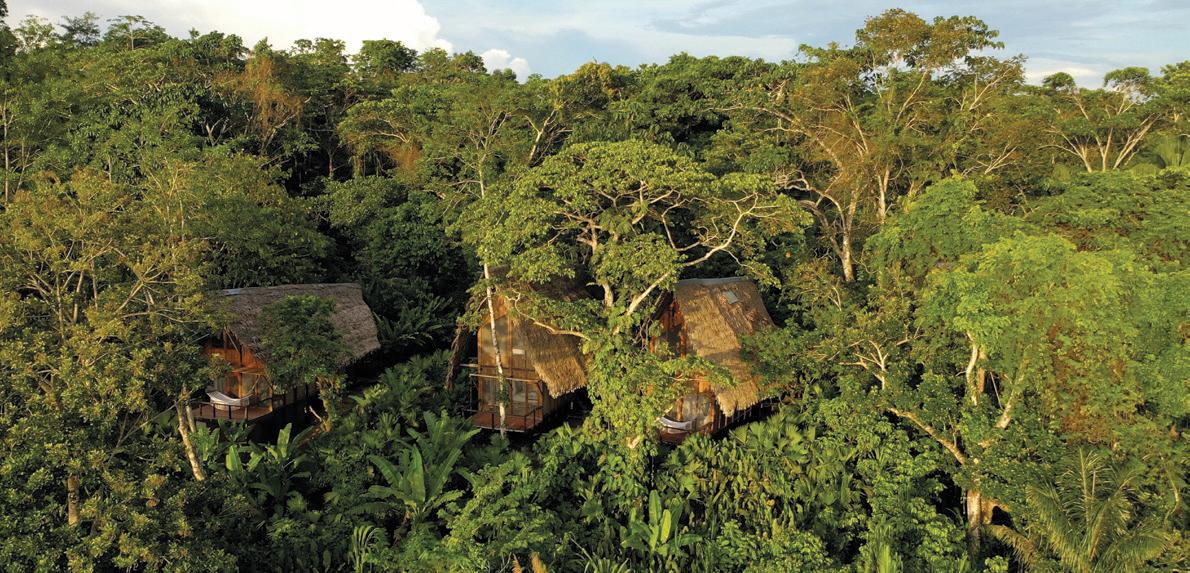
5 minute read
Calanoa: Paradise in the Jungle
A sustainable architecture for the humid tropics © Courtesy of Calanoa
Calanoa: Paradise in the Jungle
By Raye Mocioiu
Deep in the heart of the Amazon jungle lies an off-the-grid experience unlike any other. The Calanoa Jungle Hotel, described as a jewel of a hotel, is a laboratory for a sustainable Amazon settlement. Designed and operated by Diego and Marlene Samper, the hotel is a unique compound of cabins designed and built with locals in mind.
The Sampers met on a science and research expedition in Colombia’s Sierra Nevada de Santa Marta National Park in 1980 and settled in the Colombian Amazon soon after falling in love. They founded the first Calanoa here, a self-sufficient farm where they lived and worked on conservation projects.
In 1988, the Colombian drug wars forced the Sampers and their daughters to flee. A decade later, they migrated to Canada, but their love of the country stayed strong. Ten years ago, the family returned to the Amazon with a mission in mind: rebuild Calanoa, better and stronger than ever.
A Community Project
Diego designed the eight-cabin lodge, combining traditional techniques with a contemporary approach, and enlisted the help of locals of the Mocagua community to bring their dream to life. A community endeavour, the locals are as much a part of the magic of Calanoa as the art, and as such, the hotel has invested in their home region time and time again. In creating Calanoa, carpentry classes were provided, as none of the locals had the skills needed to build. The staff is local to the region, and their passion for the jungle spreads to visitors, sharing the beauty and magic in every experience.
Every part of the jungle hotel was created with sustainability in mind, from the materials used in building the structure to the replanting of the trees and palms used for the future maintenance of the buildings, and even the roofs, woven from palms. Rain is harvested, and the energy comes from solar panels. The team made use of local materials and resources, keeping each part of the process as sustainable as possible.
Everything is from the jungle, and each aspect is unique. The architecture enhances the experience: ethereal walls and light spaces improve the natural air circulation, allowing visitors to open their senses to the jungle without limits. This is all by design; Calanoa is both a living work of art and a place to educate guests on the importance of conservation.
A space of alternative educational processes, the jungle lodge seeks to contribute to the conservation of the biological and cultural diversity of the Amazon region through art, design, architecture, scientific research, community education and sustainable tourism.
Residences, workshops, and multidisciplinary projects, including cultural activities, make Calanoa a place of luxury and learning, an immersive dive into the power of alternative energies and the beauty of living off the land.
The Calanoa Foundation
For more than a decade, Calanoa has contributed to the conservation of the biological and cultural diversity of the Colombian Amazon in the Indigenous territories near the reserve, Tikuna, Cocama, Huitoto, and Yagua.
The Foundation seeks to enrich the local communities, using funding from the hotel to support community projects and participate in the conservation and recovery of ancestral knowledge and cultural practices. Currently, the Foundation is seeking funds for projects like El Yacaré, a boat that travels down the Amazon River at the request of the communities, carrying books, art, and experts on carefully curated subjects for the Amazonian population. Calanoa is also working with local experts to promote research projects that will create a biodiversity inventory of the Calanoa Reserve’s flora and fauna, creating a record of the medicinal plants found in the gardens and traditional community orchards.
The children’s choir of El Vergel, supported by Calanoa, preserves the dances, songs, and the Tikuna language. The Yacaré project contributes to conserving Indigenous languages and traditions by recording the stories and songs of the elders and generating an archive available to the communities. The Calanoa Foundation also contributes to a scholarship program for Indigenous students and provides encyclopedias and dictionaries for schools—and the students often return to contribute to Calanoa.
Art in the Amazon
Art is integral to Calanoa. As artists and conservationists, the Sampers believe that creativity is the greatest economic resource possible, and they seek to nurture it through Calanoa’s projects, combining traditional art and culture with sustainable management of forest and river resources. The result is a strengthening of cultural identity, a deeper understanding and appreciation for the land, and stronger economic well-being for the community as a whole.
Calanoa focuses on what they describe as “art for conservation,” meaning that each artistic venture contributes significantly to the community’s economic well-being, strengthening cultural and ethnic identity, and environmental conservation. The Mural Painting in Mocagua project, in which community members paint the facades of their houses with relevant motives to each family’s Indigenous clans, is a perfect example of this mission.
The Amazon offers endless opportunities for art and learning, but Calanoa takes it one step further. In 2013, in partnership with Kwantlen Polytechnic University in Vancouver, Diego and Marlene established the Amazon Field School, offering students the opportunity to seek alternative learning opportunities in a new and exciting environment: the jungle. The Amazon Field School explores topics such as creativity, imagination and aesthetic inquiry, academic research, ecology, conservation and environmental awareness, cultural awareness, community development, and environmental design.










